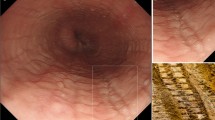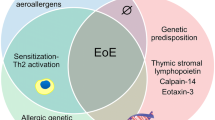Abstract
Background and aims
Multiple biopsies are recommended for the diagnosis of eosinophilic esophagitis (EoE) because inflammatory changes are frequently patchy. Reports on EoE using endocytoscopy (ECS) are limited. This present study aimed to assess if diagnostic yield improves by adding ECS on conventional white light imaging (WLI) in patients with esophageal eosinophilia (EE).
Methods
A total of 284 biopsy specimens from 71 patients with a known diagnosis of EE were enrolled and divided into the WLI group (156 specimens) or the ECS group (128 specimens). Four biopsies from 5 and 10 cm proximal to the esophagogastric junction were taken from each patient. In the ECS group, the biopsy was performed where bilobed nuclei were observed. The biopsy sensitivity for EE, eosinophil count of a single specimen and the biopsy sensitivity of each endoscopic finding were evaluated between both groups.
Results
The sensitivity of a single biopsy specimen was higher in the ECS group than that of the WLI group (62.5 vs. 41.7%, P < 0.001). In addition, the median eosinophil count in the ECS group was significantly higher [19 vs. 6.5/high-power field (HPF), P < 0.001]. For each endoscopic finding, ECS-based biopsy had higher sensitivity than that of WLI in the diagnosis of edema (33.1 vs. 11.3%, P = 0.007) and linear furrows (75.8 vs. 52%, P = 0.005).
Conclusion
This study showed that adding ECS to WLI improved the biopsy sensitivity and eosinophil detection in patients with EE.




Similar content being viewed by others
References
Dellon ES, Hirano I. Epidemiology and natural history of eosinophilic esophagitis. Gastroenterology. 2018;154:319-332.e3.
Muroi K, Kakushima N, Furukawa K, et al. Subjective symptoms in patients with eosinophilic esophagitis are related to esophageal wall thickness and esophageal body pressure. Dig Dis Sci. 2021;66:2291–300.
Dellon ES, Liacouras CA, Molina-Infante J, et al. Updated international consensus diagnostic criteria for eosinophilic esophagitis: proceedings of the AGREE conference. Gastroenterology. 2018;155:1022-103e.e10.
Lucendo AJ, Molina-Infante J, Arias A, et al. Guidelines on eosinophilic esophagitis: evidence-based statements and recommendations for diagnosis and management in children and adults. United Eur Gastroenterol J. 2017;5:335–58.
Nielsen JA, Lager DJ, Lewin M, et al. The optimal number of biopsy fragments to establish a morphologic diagnosis of eosinophilic esophagitis. Am J Gastroenterol. 2014;109:515–20.
Yantiss RK, Greenson JK, Spechler S. American registry of pathology expert opinions: evaluating patients with eosinophilic esophagitis: practice points for endoscopists and pathologists. Ann Diagn Pathol. 2019;43: 151418.
Kumagai Y, Monma K, Kawada K. Magnifying chromoendoscopy of the esophagus: in-vivo pathological diagnosis using an endocytoscopy system. Endoscopy. 2004;36:590–4.
Kumagai Y, Kawada K, Yamazaki S, et al. Endocytoscopic observation of esophageal squamous cell carcinoma. Dig Endosc. 2010;22:10–6.
Isomoto H, Matsushima K, Hayashi T, et al. Endocytoscopic findings of lymphomas of the stomach. BMC Gastroenterol. 2013;13:174.
Sasajima K, Kudo SE, Inoue H, et al. Real-time in vivo virtual histology of colorectal lesions when using the endocytoscopy system. Gastrointest Endosc. 2006;63:1010–7.
Maeda Y, Ohtsuka K, Kudo SE, et al. Endocytoscopic narrow-band imaging efficiency for evaluation of inflammatory activity in ulcerative colitis. World J Gastroenterol. 2015;21:2108–15.
Kumagai Y, Takubo K, Kawada K, et al. Endocytoscopic observation of various types of esophagitis. Esophagus. 2016;13:200–7.
Shimamura Y, Goda K, Hirooka S, et al. Observation of bilobed nucleus sign by endocytoscopy in eosinophilic esophagitis. Gastrointest Endosc. 2021;93:259–60.
Hirano I, Moy N, Heckman MG, et al. Endoscopic assessment of the oesophageal features of eosinophilic oesophagitis: validation of a novel classification and grading system. Gut. 2013;62:489–95.
Lundell LR, Dent J, Bennett JR, et al. Endoscopic assessment of oesophagitis: clinical and functional correlates and further validation of the Los Angeles classification. Gut. 1999;45:172–80.
Kimura K. An endoscopic recognition of the atrophic border and its significance in chronic gastritis. Endoscopy. 1969;3:87–97.
Kim HP, Vance RB, Shaheen NJ, et al. The prevalence and diagnostic utility of endoscopic features of eosinophilic esophagitis: a meta-analysis. Clin Gastroenterol Hepatol. 2012;10:988-96.e5.
Adachi K, Mishiro T, Tanaka S, et al. Suitable biopsy site for detection of esophageal eosinophilia in eosinophilic esophagitis suspected cases. Dig Endosc. 2016;28:139–44.
Salek J, Clayton F, Vinson L, et al. Endoscopic appearance and location dictate diagnostic yield of biopsies in eosinophilic oesophagitis. Aliment Pharmacol Ther. 2015;41:1288–95.
Shimura S, Ishimura N, Tanimura T, et al. Reliability of symptoms and endoscopic findings for diagnosis of esophageal eosinophilia in a Japanese population. Digestion. 2014;90:49–57.
Gonsalves N, Policarpio-Nicolas M, Zhang Q, et al. Histopathologic variability and endoscopic correlates in adults with eosinophilic esophagitis. Gastrointest Endosc. 2006;64:313–9.
Okimoto E, Ishimura N, Okada M, et al. Specific locations of linear furrows in patients with esophageal eosinophilia. Dig Endosc. 2017;29:49–56.
Auerbach SS, Bristol DW, Peckham JC, et al. Toxicity and carcinogenicity studies of methylene blue trihydrate in F344N rats and B6C3F1 mice. Food Chem Toxicol. 2010;48:169–77.
Author information
Authors and Affiliations
Contributions
All the authors contributed to the conception and design of the study. Material preparation, data collection, and analyses were performed by the KM. The first draft of the manuscript was written by KM, NK and KF commented on the previous versions of the manuscript. All authors have read and approved the final manuscript.
Corresponding author
Ethics declarations
Ethical statement
This study was approved by the Ethics Committee of Nagoya University and was registered in the University Hospital Medical Information Network (UMIN) Clinical Trials (No. 000033251). This study was conducted ethically in accordance with the World Medical Association Declaration of Helsinki Update 2013.
Conflict of interest
All authors declare that they have no conflict of interest.
Additional information
Publisher's Note
Springer Nature remains neutral with regard to jurisdictional claims in published maps and institutional affiliations.
Rights and permissions
Springer Nature or its licensor holds exclusive rights to this article under a publishing agreement with the author(s) or other rightsholder(s); author self-archiving of the accepted manuscript version of this article is solely governed by the terms of such publishing agreement and applicable law.
About this article
Cite this article
Muroi, K., Kakushima, N., Furukawa, K. et al. Novel endoscopic approaches using the endocytoscopy for the target biopsy in esophageal eosinophilia. Esophagus 20, 325–332 (2023). https://doi.org/10.1007/s10388-022-00963-0
Received:
Accepted:
Published:
Issue Date:
DOI: https://doi.org/10.1007/s10388-022-00963-0




